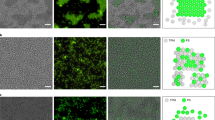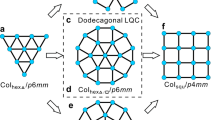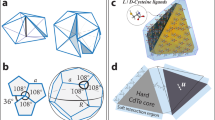Abstract
Encoding Archimedean and non-regular tessellations in self-assembled colloidal crystals promises unprecedented structure-dependent properties for applications ranging from low-friction coatings to optoelectronic metamaterials1,2,3,4,5,6,7. Yet, despite numerous computational studies predicting exotic structures even from simple interparticle interactions8,9,10,11,12, the realization of complex non-hexagonal crystals remains experimentally challenging13,14,15,16,17,18. Here we show that two hexagonally packed monolayers of identical spherical soft microparticles adsorbed at a liquid–liquid interface can assemble into a vast array of two-dimensional micropatterns, provided that they are immobilized onto a solid substrate one after the other. The first monolayer retains its lowest-energy hexagonal structure and acts as a template onto which the particles of the second monolayer are forced to rearrange. The frustration between the two lattices elicits symmetries that would not otherwise emerge if all the particles were assembled in a single step. Simply by varying the packing fraction of the two monolayers, we obtain not only low-coordinated structures such as rectangular and honeycomb lattices, but also rhomboidal, hexagonal and herringbone superlattices encoding non-regular tessellations. This is achieved without directional bonding, and the structures formed are equilibrium structures: molecular dynamics simulations show that these structures are thermodynamically stable and develop from short-range repulsive interactions, making them easy to predict, and thus suggesting avenues towards the rational design of complex micropatterns.
This is a preview of subscription content, access via your institution
Access options
Access Nature and 54 other Nature Portfolio journals
Get Nature+, our best-value online-access subscription
$29.99 / 30 days
cancel any time
Subscribe to this journal
Receive 51 print issues and online access
$199.00 per year
only $3.90 per issue
Buy this article
- Purchase on Springer Link
- Instant access to full article PDF
Prices may be subject to local taxes which are calculated during checkout




Similar content being viewed by others
Data availability
The data that support the findings of this study are available at https://doi.org/10.3929/ethz-b-000402331 under Creative Commons Attribution-NonCommercial 4.0 International license.
Code availability
Numerical simulations and analysis code that support the findings of this study are available at https://doi.org/10.3929/ethz-b-000402331 under Creative Commons Attribution-NonCommercial 4.0 International license.
Change history
08 July 2020
The online publication date in the printed version of this article was listed incorrectly as 10 June 2020; the date was correct online.
References
Millan, J. A., Ortiz, D., van Anders, G. & Glotzer, S. C. Self-assembly of Archimedean tilings with enthalpically and entropically patchy polygons. ACS Nano 8, 2918–2928 (2014).
Bohlein, T., Mikhael, J. & Bechinger, C. Observation of kinks and antikinks in colloidal monolayers driven across ordered surfaces. Nat. Mater. 11, 126–130 (2012).
Ueda, K., Dotera, T. & Gemma, T. Photonic band structure calculations of two-dimensional Archimedean tiling patterns. Phys. Rev. B 75, 195122 (2007).
Zhang, F., Liu, Y. & Yan, H. Complex Archimedean tiling self-assembled from DNA nanostructures. J. Am. Chem. Soc. 135, 7458–7461 (2013).
Chen, Q., Bae, S. C. & Granick, S. Directed self-assembly of a colloidal kagome lattice. Nature 469, 381–384 (2011).
Cong, H., Yu, B., Tang, J., Li, Z. & Liu, X. Current status and future developments in preparation and application of colloidal crystals. Chem. Soc. Rev. 42, 7774–7800 (2013).
Mayer, M., Schnepf, M. J., König, T. A. F. & Fery, A. Colloidal self-assembly concepts for plasmonic metasurfaces. Adv. Opt. Mater. 7, 1800564 (2019).
Zu, M., Tan, P. & Xu, N. Forming quasicrystals by monodisperse soft core particles. Nat. Commun. 8, 2089 (2017).
Malescio, G. & Pellicane, G. Stripe phases from isotropic repulsive interactions. Nat. Mater. 2, 97–100 (2003).
Miller, W. L. & Cacciuto, A. Two-dimensional packing of soft particles and the soft generalized Thomson problem. Soft Matter 7, 7552–7559 (2011).
Likos, C. N., Hoffmann, N., Löwen, H. & Louis, A. A. Exotic fluids and crystals of soft polymeric colloids. J. Phys. Condens. Matter 14, 7681–7698 (2002).
Dotera, T., Oshiro, T. & Ziherl, P. Mosaic two-lengthscale quasicrystals. Nature 506, 208–211 (2014).
Bos, I., van der Scheer, P., Ellenbroek, W. G. & Sprakel, J. Two-dimensional crystals of star polymers: a tale of tails. Soft Matter 15, 615–622 (2019).
Mahynski, N. A., Pretti, E., Shen, V. K. & Mittal, J. Using symmetry to elucidate the importance of stoichiometry in colloidal crystal assembly. Nat. Commun. 10, 2028 (2019).
Vogel, N., Retsch, M., Fustin, C.-A., del Campo, A. & Jonas, U. Advances in colloidal assembly: the design of structure and hierarchy in two and three dimensions. Chem. Rev. 115, 6265–6311 (2015).
Rey, M., Law, A. D., Buzza, D. M. A. & Vogel, N. Anisotropic self-assembly from isotropic colloidal building blocks. J. Am. Chem. Soc. 139, 17464–17473 (2017).
Hummel, M. E. J. et al. Ordered particle arrays via a Langmuir transfer process: access to any two-dimensional Bravais lattice. Langmuir 35, 973–979 (2019).
Volk, K., Deissenbeck, F., Mandal, S., Löwen, H. & Karg, M. Moiré and honeycomb lattices through self-assembly of hard-core/soft-shell microgels: experiment and simulation. Phys. Chem. Chem. Phys. 21, 19153–19162 (2019).
Destribats, M. et al. Soft microgels as pickering emulsion stabilisers: role of particle deformability. Soft Matter 7, 7689–7698 (2011).
Geisel, K., Isa, L. & Richtering, W. Unraveling the 3D localization and deformation of responsive microgels at oil/water interfaces: a step forward in understanding soft emulsion stabilizers. Langmuir 28, 15770–15776 (2012).
Camerin, F. et al. Microgels adsorbed at liquid-liquid interfaces: a joint numerical and experimental study. ACS Nano 13, 4548–4559 (2019).
Style, R. W., Isa, L. & Dufresne, E. R. Adsorption of soft particles at fluid interfaces. Soft Matter 11, 7412–7419 (2015).
Geisel, K., Richtering, W. & Isa, L. Highly ordered 2D microgel arrays: compression versus self-assembly. Soft Matter 10, 7968–7976 (2014).
Rey, M. et al. Isostructural solid-solid phase transition in monolayers of soft core-shell particles at fluid interfaces: structure and mechanics. Soft Matter 12, 3545–3557 (2016).
Fernández-Rodríguez, M. Á. et al. Tunable 2D binary colloidal alloys for soft nanotemplating. Nanoscale 10, 22189–22195 (2018).
Rovigatti, L., Gnan, N., Tavagnacco, L., Moreno, A. J. & Zaccarelli, E. Numerical modelling of non-ionic microgels: an overview. Soft Matter 15, 1108–1119 (2019).
Bergman, M. J. et al. A new look at effective interactions between microgel particles. Nat. Commun. 9, 503910 (2018).
Rovigatti, L., Gnan, N., Ninarello, A. & Zaccarelli, E. Connecting elasticity and effective interactions of neutral microgels: the validity of the Hertzian model. Macromolecules 52, 4895–4906 (2019).
Kryuchkov, N. P., Yurchenko, S. O., Fomin, Y. D., Tsiok, E. N. & Ryzhov, V. N. Complex crystalline structures in a two-dimensional core-softened system. Soft Matter 14, 2152–2162 (2018).
Likos, C. N. Effective interactions in soft condensed matter physics. Phys. Rep. 348, 267–439 (2001).
Malescio, G. Complex phase behaviour from simple potentials. J. Phys. Cond. Matter 19, 07310110 (2007).
Grünbaum, B. & Shephard, G. Tilings and Patterns: An Introduction (W.H. Freeman, 1989).
van Blaaderen, A., Ruel, R. & Wiltzius, P. Template-directed colloidal crystallization. Nature 385, 321–324 (1997).
Schwenke, K., Isa, L., Cheung, D. L. & Del Gado, E. Conformations and effective interactions of polymer-coated nanoparticles at liquid interfaces. Langmuir 30, 12578–12586 (2014).
Vasudevan, S. A., Rauh, A., Kröger, M., Karg, M. & Isa, L. Dynamics and wetting behavior of core-shell soft particles at a fluid-fluid interface. Langmuir 34, 15370–15382 (2018).
Vasudevan, S. A., Rauh, A., Barbera, L., Karg, M. & Isa, L. Stable in bulk and aggregating at the interface: comparing core-shell nanoparticles in suspension and at fluid interfaces. Langmuir 34, 886–895 (2018).
Conley, G. M., Aebischer, P., Nöjd, S., Schurtenberger, P. & Scheffold, F. Jamming and overpacking fuzzy microgels: deformation, interpenetration, and compression. Sci. Adv. 3, e1700969 (2017).
Crocker, J. C & Weeks, E. R. Particle Tracking Using IDL http://www.physics.emory.edu/faculty/weeks//idl/
Anderson, J. A., Lorenz, C. D. & Travesset, A. General purpose molecular dynamics simulations fully implemented on graphics processing units. J. Comput. Phys. 227, 5342–5359 (2008).
Glaser, J. et al. Strong scaling of general-purpose molecular dynamics simulations on GPUs. Comput. Phys. Commun. 192, 97–107 (2015).
Bitzek, E., Koskinen, P., Gahler, F., Moseler, M. & Gumbsch, P. Structural relaxation made simple. Phys. Rev. Lett. 97, 170201 (2006).
Harper, E. S., Spellings, M., Anderson, J. & Glotzer, S. C. harperic/freud: Zenodo DOI Release https://doi.org/10.5281/zenodo.166564 (2016).
Stukowski, A. Visualization and analysis of atomistic simulation data with OVITO – the Open Visualization Tool. Modelling Simul. Mater. Sci. Eng. 18, 015012 (2010).
Morley, S. K., Brito, T. V. & Welling, D. T. Measures of model performance based on the log accuracy ratio. Space Weather. 16, 69–88 (2018).
Acknowledgements
We thank E. Zaccarelli, F. Camerin, W. Steurer and T. Weber for discussions. We also thank M. R. Bailey for proofreading the manuscript. L.I. and M.A.F.-R. acknowledge financial support from the Swiss National Science Foundation Grant PP00P2-172913/1.
Author information
Authors and Affiliations
Contributions
Author contributions are defined based on the CRediT (Contributor Roles Taxonomy) and listed alphabetically. Conceptualization: M.-N.A., M.A.F.-R., F.G. and L.I. Data curation: F.G. Formal analysis: M.-N.A., M.A.F.-R. and F.G. Funding acquisition: L.I. Investigation: M.-N.A., M.A.F.-R., D.G. and F.G. Methodology: M.-N.A, M.A.F.-R., F.G. and L.I. Project administration: L.I. Software: M.A.F.-R. and F.G. Supervision: M.A.F.-R. and L.I. Validation: M.-N.A., M.A.F.-R., D.G. and F.G. Visualization: M.-N.A., M.A.F.-R., F.G. and L.I. Writing original draft: M.A.F.-R., F.G. and L.I. Writing review and editing: M.-N.A., M.A.F.-R., D.G., F.G. and L.I.
Corresponding authors
Ethics declarations
Competing interests
The authors declare no competing interests.
Additional information
Peer review information Nature thanks Stefano Sacanna and the other, anonymous, reviewer(s) for their contribution to the peer review of this work.
Publisher’s note Springer Nature remains neutral with regard to jurisdictional claims in published maps and institutional affiliations.
Extended data figures and tables
Extended Data Fig. 1 Compression of individual monolayers.
Surface pressure Π versus area per particle Ap and representative AFM images obtained by the simultaneous compression and deposition of a monolayer of 3CS0 microgels from a water–hexane interface onto a silicon wafer. Scale bar, 3 µm.
Extended Data Fig. 2 Agreement between measured and extrapolated values of ϕ1 and ϕ2.
The deposition process implies that ϕ1 and ϕ2 are expected to vary only along x and y, which correspond to the respective compression directions. This is particularly advantageous because ϕ1(x) and ϕ2(y) can be reliably estimated from AFM images taken along the regions where only a single hexagonal monolayer was deposited (y < 0 or x < 0). To test whether extrapolating ϕ1(x) and ϕ2(y) from such regions to the entire Si wafer provides a good estimate, we systematically compared extrapolated (ϕ1,ϕ2) pairs with the values measured from AFM images taken in regions where two monolayers were deposited onto each other (x, y > 0), where a slight difference in height between the particles from the two depositions could be leveraged to measure ϕ1 and ϕ2 independently. The dots denote the different measurements based on AFM images taken for x and y > 0. RMSE, root-mean-square error.
Extended Data Fig. 3 Depositing two monolayers onto the same substrate leads to in-plane packing.
AFM images of particle monolayers with similar area per particle (a, 0.3 µm2; b, 0.4 µm2) but obtained after single (a, and red curve in c) and double (b, and blue curve in c) deposition, respectively. c, The height profiles along two representative line scans show that particles from both single and double depositions sit at the same height. The patterns arising from double depositions are therefore not the result of an out-of-plane stacking, but originate from the re-arrangement of the particles of the second monolayer into in-plane interstitial positions. Furthermore, the maximum height of the particles from the second deposition (second, fourth and sixth peak of the blue curve) is systematically higher (by about 10 nm) than the ones from the first deposition (first, third and fifth peak of the blue curve), owing to the in-plane compression exerted by the previously deposited particles. This fact was leveraged to estimate ϕ1 and ϕ2 from individual images, as particles arising from different depositions can be singled out via a height threshold (see Extended Data Fig. 2). Scale bar, 3 µm.
Extended Data Fig. 4 Effect of α on the shape of the interaction potential and on bond-orientation order.
Top, generalized Hertzian potential U(r) (left) and corresponding interparticle force F(r) (right) as a function of the normalized separation distance r/σ for different values of α. Bottom, ψ3, ψ4 and ψ5 of the simulated ground-state structures as a function of ϕ1 and ϕ2 for different values of α.
Extended Data Fig. 5 Distribution of the observed bond orientational order.
ψk (with k ∈ 3,.., 12) is represented through box and whisker plots for 3CS0 (a) and 3CS1 (b). The bottom and top edges of the box indicate the 25th and 75th percentiles, the central red line indicates the median, and the lower and top whiskers indicate values equal to the median ±1.5 times the interquartile range. The inset shows the interquartile range (IQR) of the observed ψk. c, Measured values of ψ3, ψ4, and ψ5 for 3CS0 microgels as a function of ϕ1 and ϕ2.
Extended Data Fig. 6 Experimental and simulated intermediate superstructures.
AFM images of intermediate superstructures obtained with 3CS0 microgels and their corresponding simulation snapshots. The values in brackets indicate the respective (ϕ1,ϕ2) pairs. The simulations were run with α = 1.9. The scale bars in the AFM images are 5 µm.
Extended Data Fig. 7 Estimating ground-state structures by molecular dynamics simulations.
Analysis of molecular dynamics simulations showing the structural evolution towards minimum energy configurations as a function of time and reduced temperature kT/ε for two different (ϕ1,ϕ2) pairs, namely (1.4,1.4) in panels a and c, and (0.9,1.3) in panels b and d. For illustration purposes, the disks in panels a and b are drawn with a diameter of 0.6σ. The FIRE algorithm41 was used to minimize the potential energy while bringing kT/ε from 10−4 to 0. The insets in c and d show simulations snapshots taken after 2 × 107 steps.
Extended Data Fig. 8 Relaxing the constraint on the mobility of the first monolayer leads to simpler structures.
Simulated ground-state structures obtained at different packing fractions ϕ1 + ϕ2 for α = 1.9 when all the particles are allowed to re-arrange freely. For illustration purposes, the particles are drawn with a diameter of 0.6σ.
Extended Data Fig. 9 Realization of target structures over centimetre-scale substrates.
AFM images of honeycomb lattices obtained from double depositions of 5CS1 (ϕ1 ≈ ϕ2 ≈ 1.2) (a), 3CS0 (ϕ1 ≈ ϕ2 ≈ 1.4) (b) and 3CS1 (ϕ1 ≈ ϕ2 ≈ 1.5) (c) microgels. d–i, Optical microscope images of two different superstructures deposited over two different 2 cm × 2 cm substrates by keeping the surface pressure constant throughout each deposition. The optical images were taken at random locations that were more than 1 mm apart from each other. The scale bars are 10 µm for the optical microscopy images and 2 µm for the AFM image in the insets. The surface pressures during the sequential depositions were Π1 = Π2 = 18 mN m−1 for d–f and Π1 = 26 mN m−1 and Π2 = 9 mN m−1 for g–i.
Rights and permissions
About this article
Cite this article
Grillo, F., Fernandez-Rodriguez, M.A., Antonopoulou, MN. et al. Self-templating assembly of soft microparticles into complex tessellations. Nature 582, 219–224 (2020). https://doi.org/10.1038/s41586-020-2341-6
Received:
Accepted:
Published:
Issue Date:
DOI: https://doi.org/10.1038/s41586-020-2341-6
This article is cited by
-
In-situ study of the impact of temperature and architecture on the interfacial structure of microgels
Nature Communications (2022)
-
Total synthesis of colloidal matter
Nature Reviews Materials (2021)
Comments
By submitting a comment you agree to abide by our Terms and Community Guidelines. If you find something abusive or that does not comply with our terms or guidelines please flag it as inappropriate.



